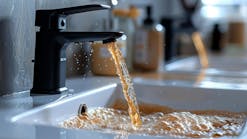About the author: Justin Ramsey is marketing manager for Pro Products LLC. Ramsey can be reached at [email protected] or 800.285.9176. Preston Short is national sales manager, water treatment division for Pro Products LLC. Short can be reached at [email protected] or 800.285.9176.
Justin Ramsey & Preston Short
undefined
Sanitization is an underutilized word in the water treatment industry. As dealers, we like to believe that our water conditioning equipment is immune to microbial contamination and will require minimal service throughout its life. This mindset could be costing dealers thousands of dollars.
Why Sanitize?
If water treatment equipment is not properly sanitized, bacteria can grow and multiply on the inside surfaces of tanks and hoses. A reverse osmosis (RO) unit will capture microorganisms in its filters. As the unit sits idle, those organisms can spread to its hard surfaces, causing odor, taste and color issues with the water and even spreading disease.
Water softeners are also susceptible to microorganisms. Contaminants are typically introduced from the mainline during boil water advisories or when dealing with well contamination issues. The contaminated water is brought into the system and run through the resin. As the system sits idle, the microorganisms can spread, causing odor, taste and clarity issues.
The Water Quality Assn. (WQA) handbook, “Guidelines for Disinfection and Sanitization of Water Treatment Equipment,” states: “Sources of contamination could be introduced to the water treatment system during manufacturing, installation and service of the system. Manufacturers and dealers of water treatment equipment have an obligation to provide sanitary equipment to their customers.” This means that every time service technicians touch the equipment, they should sanitize the unit and charge the customer for this service.
Multiple Methods
There are several low-cost options to sanitize equipment. Liquid chlorine bleach (5.25%) is the most common sanitizer. Its relatively low price and two-minute contact time at 50 parts per million (ppm) have worked well for years. The product does have drawbacks, however. As it gasses off, bleach continually loses strength, making it difficult to sanitize properly. Bleach can also damage resin, rugs, carpet, towels, truck mats and technician uniforms.
Hydrogen peroxide is the next most commonly used sanitizer. Also readily available to dealers, hydrogen peroxide converts to oxygen when flushed from the system. It requires 30,000 ppm and three hours to kill microorganisms, however, which is not an ideal scenario when trying to accomplish several service calls in one day.
Chlorine dioxide tablets have also been used for sanitization by making a liquid solution of 200 ppm with 10 minutes of contact time. Neither WQA nor the U.S. Environmental Protection Agency (EPA) provide directions for using this product in water treatment equipment.
A new option for the water treatment industry is Sani-System, a quat-based sanitizer. It is the only product on the market that is both EPA and NSF approved for use in water treatment equipment. It comes in exact doses for water softeners and RO units that are poured directly into the unit and kill 99.99% of microorganisms in 60 seconds. One drawback of this product is that overdoses can cause bubbles and a soapy aftertaste.
Profit Opportunity
After a sanitizer has been selected, dealers must add sanitization to the service call routine. A sampling of dealers at the WQA Aquatech USA 2011 tradeshow found that each service technician doing routine service calls services an average of eight water softeners and four RO units per day. If each unit was sanitized and the homeowner was charged $9.50, the annual net profit would be $24,960 per service technician.
The units need to be sanitized not only during every service call but also after well contamination or boil water advisories. The American Water Works Assn. and EPA reported that there were more than 700 boil water advisories per day and more than 1,000 contamination reports in 2010 alone. This means contaminated water entered equipment more than 1,000 times during that year, possibly affecting as many as 500 customers at one time. One boil-water advisory could net nearly $5,000 in profits for a dealer with sanitization alone.
With each sanitization, it would also be wise to clean the resin or change the filters to ensure the units are operating at maximum capacity.
Educating Customers
A few easy steps can help make sanitization a routine task for technicians and customers. With each new installation, technicians should explain to homeowners the importance of maintaining and sanitizing water softeners or RO units to keep them running at peak efficiency. Leaving an informational pamphlet with the names of contaminants that a reccurring sanitization program will kill, such as MRSA, E. Coli and rhinovirus, can be helpful. Service stickers or hanging tags can be used to let customers know when the next sanitization is recommended or when the next service appointment is scheduled.
During service calls for existing customers, always sanitize the unit before leaving. Provide the same informational package for the customer and begin using the service reminders. Add a sanitization charge at the bottom of the invoice and attach the information pamphlet. These steps eliminate the need for service technicians to “hard sell” sanitization. If customers question the charge, it is important to educate them on how vital it is to keep their units sanitized and contaminant free.
With a stalled economy and new home sales at an all-time low, isn’t it time to embrace sanitization by adding it to your services and bottom line?
Download: Here


